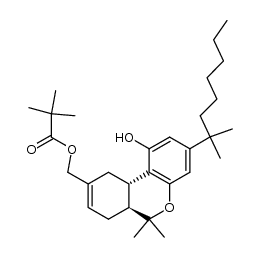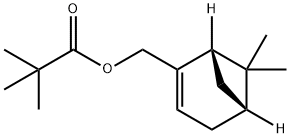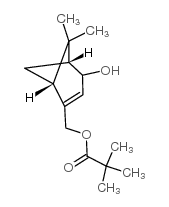112924-45-5
| Name | (6aS,10aS)-9-(hydroxymethyl)-6,6-dimethyl-3-(2-methyloctan-2-yl)-6a,7,10,10a-tetrahydrobenzo[c]chromen-1-ol |
|---|---|
| Synonyms |
6H-Dibenzo[b,d]pyran-9-methanol, 3-(1,1-dimethylheptyl)-6a,7,10,10a-tetrahydro-1-hydroxy-6,6-dimethyl-, (6aS,10aS)-
(6aS,10aS)-9-(Hydroxymethyl)-6,6-dimethyl-3-(2-methyl-2-octanyl)-6a,7,10,10a-tetrahydro-6H-benzo[c]chromen-1-ol (6aS,10aS)-9-(Hydroxymethyl)-6,6-dimethyl-3-(2-methyloctan-2-yl)-6a,7,10,10a-tetrahydro-6H-benzo[c]chromen-1-ol Sinnabidiol 1,1-Dimethylheptyl-11-hydroxytetrahydrocannabinol HU-211 Dexanabinol |
| Description | Dexanabinol (HU-211) is an artificially synthesized cannabinoid derivative and lacks cannabimimetic effects. Dexanabinol exhibits not only the antioxidant and neuroprotective activities in brain but also anti-inflammatory activity by inhibiting NF-κB and decreasing cytokines such as TNFα and interleukin-6, which could ensure the integrity of BBB and reduce cell apoptosis and death. Dexanabinol is widely used in head injury or stroke treatment and has been shown to be safe in animals and humans[1]. |
|---|---|
| Related Catalog | |
| Target |
NF-κB TNFα IL-6 |
| References |
| Density | 1.0±0.1 g/cm3 |
|---|---|
| Boiling Point | 470.1±45.0 °C at 760 mmHg |
| Molecular Formula | C25H38O3 |
| Molecular Weight | 386.567 |
| Flash Point | 238.1±28.7 °C |
| Exact Mass | 386.282104 |
| PSA | 49.69000 |
| LogP | 8.19 |
| Vapour Pressure | 0.0±1.2 mmHg at 25°C |
| Index of Refraction | 1.526 |
|
~98% 
112924-45-5 |
| Literature: Tetrahedron: Asymmetry, , vol. 1, # 5 p. 315 - 318 |
|
~% 
112924-45-5 |
| Literature: Tetrahedron: Asymmetry, , vol. 1, # 5 p. 315 - 318 |
|
~% 
112924-45-5 |
| Literature: Tetrahedron: Asymmetry, , vol. 1, # 5 p. 315 - 318 |
|
~% 
112924-45-5 |
| Literature: Tetrahedron: Asymmetry, , vol. 1, # 5 p. 315 - 318 |
|
~% 
112924-45-5 |
| Literature: Tetrahedron: Asymmetry, , vol. 1, # 5 p. 315 - 318 |
|
~% 
112924-45-5 |
| Literature: Tetrahedron: Asymmetry, , vol. 1, # 5 p. 315 - 318 |
| Precursor 5 | |
|---|---|
| DownStream 0 | |





